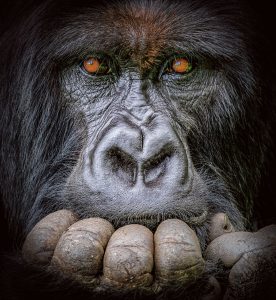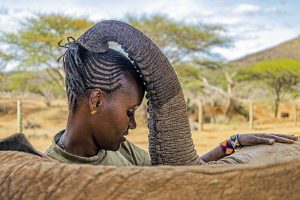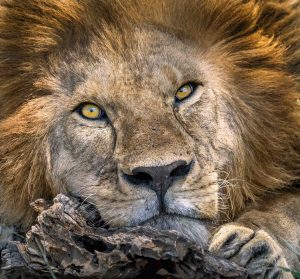
Greeting visitors both on their way in and on their way out of the 2022 Benjamin Mkapa African Wildlife Photography Awards, now on display at the Society of the Four Arts, is the striking, close-up image of Duke, an orphaned caracal.
Shot by South African photographer Jon Warburton at the Zimanga Private Game Reserve in KwaZulu-Natal, South Africa, the image captures the cat with his pink tongue out lapping up water in a puddle. The wild caracal is undergoing rehabilitation and rewilding before being released back into the wild.
“I took this shot to portray the cat’s vibrant personality,” Warburton says in the description of his photo.
The exhibition presents the winning entries of the 2nd Annual Benjamin Mkapa African Wildlife Photography Awards, a collaboration between the African Wildlife Foundation (AWF) and Nature’s Best Photography (NBP). The global competition attracts photographers at all levels of expertise who advocate for wildlife conservation.
The African Wildlife Foundation is the only African global conservation organization protecting wildlife and its ecosystems. Nature’s Best Photography was established in 1995 to inspire, educate, and motivate conservation of the natural world through the art of photography.
Categories include: African Conservation Heroes, Coexistence and Conflict, African Wildlife at Risk, Fragile Wilderness, African Wildlife Behavior, African Wildlife Portraits, Africa’s Backyard Wildlife, Art in Nature, Creative Digital, Mobile, Africa in Motion/Video, and two Youth Photographers of the Year, one inside Africa and one international.

The competition is named in honor of the late Tanzanian President Benjamin Mkapa (1938–2020), who was dedicated to conservation education throughout Africa. Winning images were selected from more than 9,500 entries representing 57 countries.
Also making a statement with his photograph is Swedish photographer Tom Svensson’s “highly honored” photo in the Coexistence and Conflict category of a young girl, Olivia Adefowora, sitting behind a severed elephant foot. She’s sitting cross-legged on the ground, her two arms wrapped around the giant foot.
“I like the idea of taking photos of young people, such as Olivia, with animal specimens to show the world we need to act now or this may be the result,” he says.
As stars align, so did the three zebras in the black-and-white image captured by Pennsylvania photographer Vicki James, who received a “highly honored” recognition in the Art in Nature category for her portrait of three zebras lined up in perfect symmetry, their reflections mirrored back in the water they are drinking. The photo was shot at Amboseli National Park in Kenya.
Another “highly honored” image in that category is Namibian photographer Rian van Schalkwyk’s image of giraffe, zebra, ostrich, springbok and gemsbok (a national symbol of Namibia) drinking at the Etosha National Park in Namibia.

The winning photo in the Fragile Wilderness category is Poland’s Thomas Szpila for his photo titled Ostrich, taken in the Damaraland region of Namibia, depicting 100 adolescent ostriches (organized in groups called kindergartens) under the watchful eye of one adult male.
A photo of a white-bellied pangolin cradled in a veterinarian’s hand taken by South African photographer Prelena Soma Owen won the Creative Digital award. The pangolin was being hand-reared and nursed before it will be released into the wild after 12 to 18 months of rehabilitation.
In the African Wildlife Portraits category, a close-up photograph titled African Lion, captured at the Ngorongoro Conservation Area in Tanzania by Russ Burden of Parker, Colo., took the winning prize. He positioned himself to get a good vantage point from which to capture the image. Waiting patiently for the lion to look his way, a sudden cloud passed by and blocked out the sun. The lion opened his eyes and Burden captured what became a winning photograph.
The winning image in the Art in Nature category was by Hong Kong-based photographer Paul McKenzie for his photo titled Lesser Flamingos, taken in Lake Sola, Kenya, from a light aircraft.

The aerial image captures a broadscape of flamingos feeding in shallow water surrounded by a small green island. The image is striking for its contrasting colors of the blue ocean, green island and white flocks of flamingos dotting the landscape.
The grand prize winner, a photograph titled Mountain Gorilla taken by Michelle Kranz of Boulder, Colo., at Volcanoes National Park in Rwanda, shows a close-up of a silverback gorilla, its two red eyes like burning coals staring intensely at the viewer.
“Their work (the photographers) values the essential role of conservation efforts in a thriving, modern Africa,” said Meg Whitman, U.S. Ambassador to Kenya, at the awards ceremony in October 2022, about the competition. “They use their talents to encourage us to appreciate the many creatures — great and small — with whom we share this planet.”
Editor’s note: Technical difficulties prevented the posting of this story; we apologize for the short time remaining to see it.
The 2022 Benjamin Mkapa African Wildlife Photography Awards exhibition runs through Sunday at the Society of the Four Arts, Palm. Tickets are $10 (no charge for Four Arts members and children 14 and under). Tickets may be purchased in advance via The Four Arts app, online at fourarts.org, or by calling 561-655-7226. Same-day tickets are available in person at the galleries entrance inside the O’Keeffe Building. Hours are Sunday 1 to 5 p.m., and Wednesday through Saturday from 10 a.m. to 5 p.m.